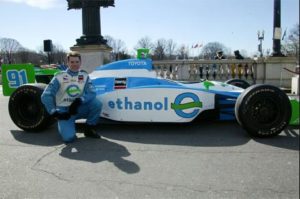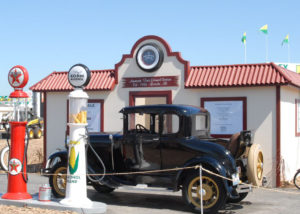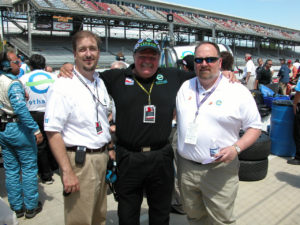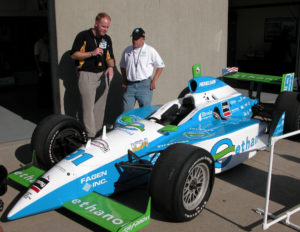Prologue: Priming the Pump
Ethanol was no overnight success story. It was a very long road to getting a place at the pump, starting as early as the first combustion engines and horseless carriages.
Some of the world’s greatest inventors praised alcohol as a fuel. Alexander Graham Bell is quoted as saying in 1917, “Alcohol makes a beautiful, clean and efficient fuel… Alcohol can be manufactured from corn stalks, and in fact from almost any vegetable matter capable of fermentation… We need never fear the exhaustion of our present fuel supplies so long as we can produce an annual crop of alcohol to any extent desired.”
Henry Ford’s Model T engine was introduced in 1908 and was capable of running on gasoline, kerosene, or ethanol but discovery of new oil fields in Texas and Prohibition intervened to make gasoline the dominant fuel. Even when it was found ethanol helped solve the problem of gasoline “engine knock,” General Motors and Standard Oil decided that adding lead to the fuel was a better solution, so leaded gasoline became the regular fuel for motorists in 1924.But Henry Ford still supported ethanol use in motor vehicles. In 1925, Ford called it, “the fuel of the future” that is “in every bit of vegetable matter that can be fermented. There’s enough alcohol in one year’s yield of an acre of potatoes to drive the machinery necessary to cultivate the fields for a hundred years,” Ford said in a September 1925 interview with the New York Times.
Fast forward 50 years and the Arab oil embargo creates a worldwide energy crisis, leading to increased interest in alternative energy sources. President Jimmy Carter creates federal incentives for ethanol production, but still the oil industry maintains its grip on the nation’s fuel supply.
Even when health problems from lead in gasoline became apparent in the 70s, leaded gasoline for use in on-road vehicles was not completely phased out until 1996. While ethanol began gaining some ground at that point as an additive, MTBE became the oil industry’s favorite – until the early 2000’s when states begin banning that additive due to ground water and soil contamination and EPA began a phase out of its use.
At long last, enough other additives had crashed and cleared the field for ethanol to take the lead.
Meanwhile, while ethanol had always been a favored by the racing industry because of its high octane properties, it was left out of Indy Car racing in 1964 after a fiery double fatality crash in the Indianapolis 500 made the United States Auto Club ban gasoline and require all cars to use methanol, a rule which would stay for over 40 years before ethanol was given the chance to compete.
The pieces finally began to come together for the ethanol industry in 2005 when both the Indy Racing League, and the nation itself, began a journey toward the first milestone of 10 percent ethanol fuel.
The intersection of promotion and policy

Missouri Senator Jim Talent, Indiana Senator Evan Bayh, IRL’s Tony George, Ron Hemelgarn, and in the car, the driver, Paul Dana
IRL Chief Executive Officer Tony George made the announcement March 3, 2005, at historic Union Station in Washington, D.C., together with ethanol industry leaders and lawmakers from major corn growing states. “Today marks a new and exciting chapter in the league’s young history, as we announce that ethanol will be our source of fuel for powering these sleek Indy cars for many years to come,” said George.
Among those in attendance that sunny but freezing cold day were U.S. Senators Jim Talent (R-MO), Evan Bayh (D-IN) and John Thune (R-SD), along with representatives from the Renewable Fuels Association, American Coalition of Ethanol and National Corn Growers Association.
The target for the 2006 season was 90% methanol and 10% ethanol for the IndyCar Series, moving to 100% fuel-grade American-made ethanol in 2007. The League had been in discussions for several years with a coalition of ethanol industry companies led by the major ethanol facility engineering and construction firms ICM Inc., Fagen Inc., and Broin Companies.
Dave Vander Griend, CEO of Witchita, Kansas-based ICM, said at the time the goal was to demonstrate the benefits of ethanol as a performance fuel. “And we feel that partnering with the Indy racing league, there’s no better way to really demonstrate to the public that this fuel is good enough for Indy and it’s a great fuel for your car also.”
The centerpiece for the announcement that day was a shiny new Indy race car detailed in neon green and sky blue with a stylized small e logo and the word ethanol emblazoned on the side. A handsome young man in a racing suit to match the car posed for photos with the politicians. His name was Paul Dana and he was watching his dream come true. Two dreams, in fact. His dream to get Indy cars fueled with ethanol and his dream to be behind the wheel on the track in the big league.
Need for Speed
 Dana was unquestionably a driving force behind the switch to ethanol. A native of St. Louis with a degree in journalism, Dana was bitten by the racing bug in the mid-1990s and began to see some ways the industry could become more environmentally friendly.
Dana was unquestionably a driving force behind the switch to ethanol. A native of St. Louis with a degree in journalism, Dana was bitten by the racing bug in the mid-1990s and began to see some ways the industry could become more environmentally friendly.
“I’ve always been a little bit of a weird duck in racing in that I have been an environmentalist and thought about ways that we could take our leadership position as drivers and put that at the disposal of something useful,” Dana said in an interview. Not yet 30 years old, Dana was a savvy marketer who was able to convince both the ethanol industry and the IRL of the benefits of using the homegrown fuel.
“Racing exists as an industry to sell cars and tires and motor oil and here we’ve got this great American success story in ethanol,” Dana continued. “The ag industry has developed a very viable fuel industry as a secondary product and with the IndyCar Series being based in the Midwest, it’s a natural fit.”
Ethanol is a natural fit for all kinds of racing as it turns out, but Indy was able to make the switch smoothly and seamlessly because the Indy Racing League had been using 100 percent methanol for since its formation in 1996, and ethanol is very similar to methanol. Ethanol is less flammable than gasoline and can easily be extinguished with water. It has virtually the same octane rating (108.6 for ethanol vs 108.7 for methanol). The difference is, methanol is a poisonous chemical derived through synthetic processes, while pure ethanol is produced by factory fermentation of organic matter, and you can in fact drink it. When the league transitioned to 100 percent “fuel grade” ethanol in 2007, it was actually only 98% pure ethanol with a two percent denaturant added to render it undrinkable.
Even though the transition to ethanol would not begin until 2006, Paul Dana had his ride for 2005 in the No. 91 Ethanol Hemelgarn Dallara/Toyota/Firestone with the green and blue ethanol paint scheme and he could barely wait to get started. The first race was the Toyota Indy at Homestead Miami Speedway on March 6 and Dana got off to a great start with a tenth-place finish. He competed in two more races before fracturing two vertebrae in a crash May 13 during practice for the 2005 Indy 500.
2005 Indy 500 Ethanol Demo
A promotional media event to introduce race fans to the ethanol switchover was held on May 27, two days before the 2005 Indianapolis 500. The Team Ethanol car would run ten laps around the Indianapolis Motor Speedway fueled with a 50/50 ethanol and methanol blend.
Despite having a broken back and wearing a brace from his injury just two weeks prior, Paul Dana was determined be there at the track to see his replacement Jimmy Kite drive the Team Ethanol car those historic ten laps.
“It is gratifying to see this program finally come to life after three years,” Dana said. “Over 30 ethanol industry companies have joined forces to get us here. The car went over 220 mph, so we know the fuel works and it is going to be great to see all 33 cars running on ethanol in 2007.”
Dana did interviews from the Indianapolis Speedway press room on race day, mostly seated and still in pain from his recent injury.
 “Today was the culmination of about three years of work on the part of a lot of people, both in the ethanol industry and on the technical side with the Indy Racing League,” said Dana in an interview with Chuck Zimmerman with AgWired that day. “It took several years of discussions to really make it happen.”
“Today was the culmination of about three years of work on the part of a lot of people, both in the ethanol industry and on the technical side with the Indy Racing League,” said Dana in an interview with Chuck Zimmerman with AgWired that day. “It took several years of discussions to really make it happen.”
Dana explained the process to make the switch. “Next year will be a transition year which we had to do in concert with Honda, Toyota and General Motors to not upset the apple cart too much in terms of their R&D,” he said. “Race engines are designed many years out. So, the blend year next year is just a compromise so they can continue to develop their motors around the new fuel.”
Ethanol was a natural choice for Indy because it’s an octane booster, which means it has a high-octane content that raises the detonation point for the motor, which in turn allows the engine management system to run higher compression ratios, meaning more horsepower. “It also burns a little cleaner and cooler, which is why Indy cars have always run on alcohol fuels because they burn so cold,” said Dana. “It’s a very simple fuel, but very effective, very high performance and it’s very easy to get motors to run on it.”
Dana said the Indy Car League became interested in making the switch to ethanol because they are all about technical leadership. “From the standpoint of energy policy and putting racing on a more sustainable footprint, they wanted to be the first because that’s what they’re all about and I know they are as excited about it as the people in the ethanol industry are,” said Dana.
He expressed hope that corn farmers will be proud of Team Ethanol. “Ultimately we’re representing the corn growers with the program,” he said. “We hope that in ’07 when the IRL runs on 100 percent ethanol that will become a lightning rod for calling attention to the industry.”
His message to consumers about using ethanol in their vehicles was simple. “In a nutshell, I drive on it and my car goes 220 miles an hour. Any questions?”
An EPIC Event
The media event around the 2005 Indy 500 was the first public launch of a new organization to support the racing promotion effort. The Ethanol Promotion and Information Council, which went by the acronym EPIC, was formed to bring ethanol organizations and refineries together under one umbrella to reach consumers with the facts about the fuel. Tom Slunecka was named Executive Director of the new council, which was tasked with managing the promotion around ethanol and the Indy Racing League once the partnership became a reality.
“Political efforts have been paramount in the ethanol industry to date, but promotion and education come right on its heels if we want to reach the goals of U.S. energy policy,” said Slunecka during an interview at the event. “What we’re trying to do with this effort is increase the demand for ethanol, which ultimately increases the price of corn.”
Slunecka came from a South Dakota farming family and had spent the previous six years as director of marketing for the National Corn Growers Association, specifically working on new markets for corn, since farmers were improving productivity every year and prices reflected that increasing supply. This was an opportunity for corn growers, who normally marketed to livestock producers, to target consumers with a shiny new product that was good for the environment.
 Using consumer marketing research and focus groups, EPIC created the stylized small e logo featured in all the Indy Car promotions, using bright blue and green to symbolize the environmental aspects of ethanol. “Our dream is that someday everyone knows that e just like they know the Nike swoosh,” Slunecka said. “These efforts are bringing agriculture to a new level.”
Using consumer marketing research and focus groups, EPIC created the stylized small e logo featured in all the Indy Car promotions, using bright blue and green to symbolize the environmental aspects of ethanol. “Our dream is that someday everyone knows that e just like they know the Nike swoosh,” Slunecka said. “These efforts are bringing agriculture to a new level.”
“For many Americans, driving to work is one of the most important things that they do,” said Slunecka. “Consumers are truly the benefactors of what we are doing here.”
EPIC had the powerful backing of Broin, Fagan, and ICM, as well as the support of both the Renewable Fuels Association and the American Coalition for Ethanol (ACE). Team Ethanol was a very expensive promotional vehicle, and it was important to get as much funding as possible from the industry.
ACE Chief Marketing Officer Ron Lamberty gave Paul Dana full credit for pulling together the dollars. “Paul came into my office and asked for some help sponsoring a race team,” said Lamberty. “I told him our race budget was about $3000 and he said he needed about a million and so we were a little short. Then he asked for my Rolodex.”
Lamberty said Dana was able to make it happen when he did because he was a very enthusiastic marketer with great timing. “I think Paul knew there was a chance the IRL would switch fuels and knew that we had to make ourselves as an industry visible,” Lamberty said.Ethanol brought new life that year to Hemelgarn Racing, a struggling team owned by Ron Hemelgarn that had slowed down after winning the Indy 500 in 1996 and the IRL championship in 2000 with Buddy Lazier. Hemelgarn got into racing as the owner of a fitness club chain in Toledo, Ohio because he wanted to promote his business.
“The heritage of America is agriculture and the American farmer,” said Hemelgarn during a trackside interview at the 2005 Indy 500. “Ethanol will someday be a household word just like gasoline.”
Remy International, Inc. and Life Fitness were additional associate sponsors for the #91 Ethanol Hemelgarn Racing entry and the team’s 2005 roster of supporting partners under the ethanol banner also included nearly 30 equipment and process technology vendors and suppliers to the ethanol industry.
Meanwhile, Jimmy Kite, who intended to compete in the 2005 NASCAR Craftsman Truck Series before being called up to replace Dana, became the one who made history with the ethanol car demo run. “It was exciting to be a part of this historic moment in IRL history,” Kite said. “It was great that we could show people today that this car can run strong and get up to speed.”Kite made his fifth and final Indianapolis 500 start in the 32nd position on the starting grid and was out after 47 laps, but those 10 laps he made around the track two days before will forever give him a place in ethanol history.
The winner that year was the dashing young Brit Dan Wheldon, who won for the first time and dominated the series in 2005, even though the big story was rookie driver Danica Patrick. She was the fourth woman to compete in the Indy 500 and the first to lead a lap, eventually winding up in fourth place. Danica’s presence was a boost to the IRL’s television ratings, which ended up giving Team Ethanol a wider audience than expected, since they ended up being teammates in 2006.
States Race Past Ethanol Policy in 2005
As the IRL prepared to move to ten percent ethanol in 2006, the Energy Policy Act of 2005 was signed on August 8, propelling the rest of the country toward using ten percent ethanol almost exclusively in regular gasoline down the road a piece. But many corn belt states were already looking ahead to higher blends as a way to get there faster.
The drive by corn state lawmakers to implement the Renewable Fuel Standard began immediately after the bill was signed. U.S. Senator Jim Talent (R-Mo.) joined with Senators Byron Dorgan (D-N.D.), John Thune (R-S.D.) and Tim Johnson (D-S.D.) called on EPA to move quickly to implement the new national standard for renewable fuels such as ethanol and biodiesel. Gas prices were at record highs, mainly due to disruptions caused by Hurricane Katrina. “Renewable fuels are a good idea any time, but with oil prices as high as they are now, the faster we can get renewable fuels in circulation, the more relief we can provide people,” said Sen. Talent at the opening of an E-85 fuel station in St. Charles, Missouri in September 2005. “E85 is selling at places in Missouri for up to a dollar a gallon less than unleaded fuel.”


